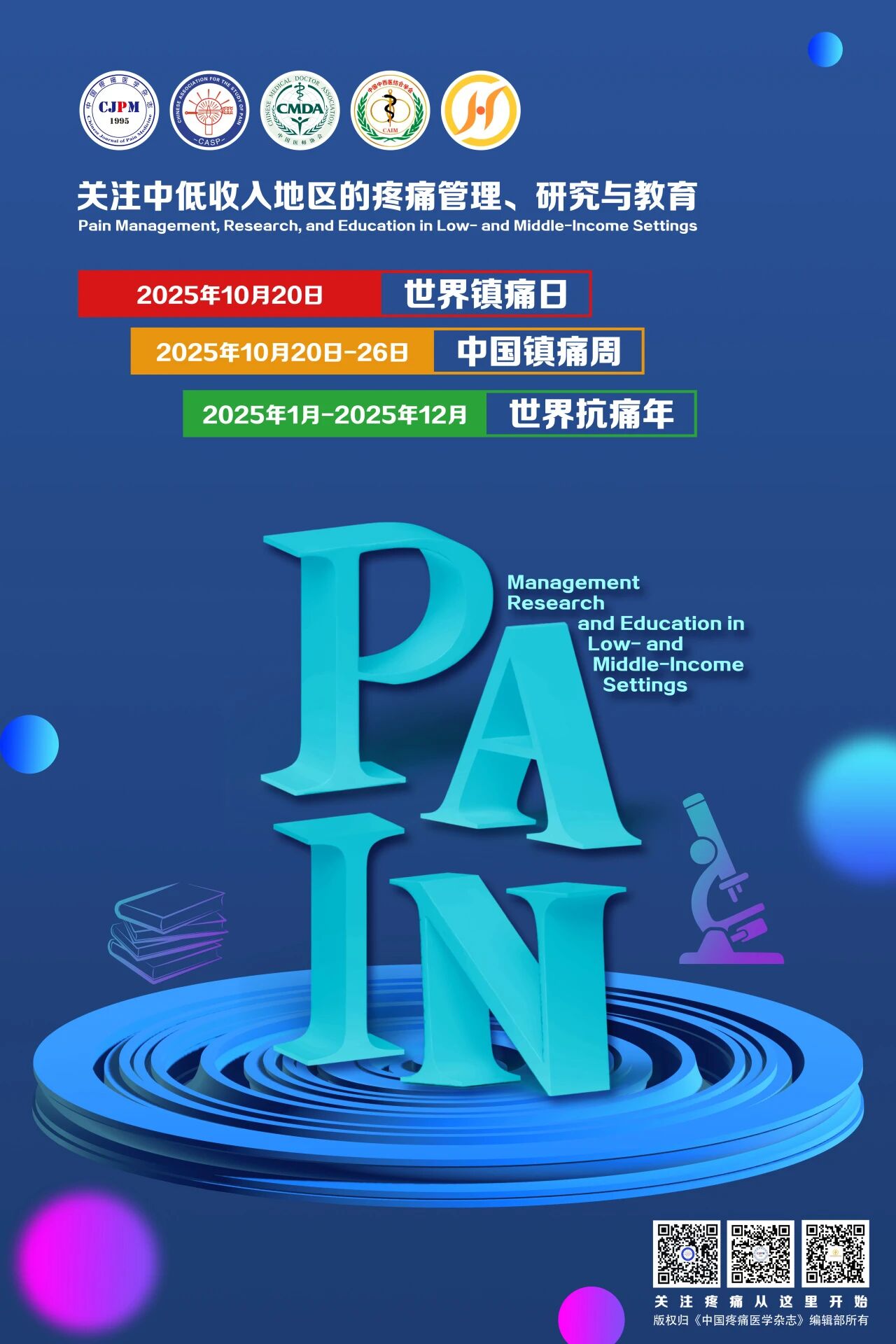2004年起,国际疼痛学会(IASP)倡议设立“世界镇痛日”,确定每年10月第三个周一为“世界镇痛日(Global Day Against Pain)”。2025年世界镇痛日的主题是:"关注中低收入地区的疼痛管理、研究与教育(Pain Management, Research, and Education in Low-and Middle-Income Settings)"。这一主题超越了中低收入国家(LMICs)的范畴,还包括高收入国家中的低收入环境及重点人群,如原住民、多元文化群体及难民。通过关注"中低收入地区",我们认识到所有地区和医疗体系中都存在社会经济挑战与不平等问题。这种方法将目光从地理转移到具体情境,有助于形成更具包容性的认知,并制定更贴合实际的疼痛管理策略。来自24个国家的35名工作组成员已自愿为该倡议贡献力量,其中超过60%来自中低收入国家。

01
2025抗痛年目标
2025抗痛年将明确中低收入地区下疼痛应对工作面临的挑战与机遇。其核心目标包括:
倡导为高质量研究提供更多资金支持,填补关键研究空白;
改进卫生专业人员教育,提升疼痛护理水平,确保所地区的人群都能获得高质量疼痛管理服务;
加强临床医生的疼痛教育培训,推广疼痛自我管理模式,鼓励慢性疼痛的跨学科和多学科护理1;助力社区层面和全球范围内实现健康公平。
02
为何关注中低收入地区
从全球范围来看,疼痛是重大公共卫生问题,其带来的负担在中低收入国家以及高收入国家的弱势群体中分布尤为不均2,3。未来几十年,中低收入国家因疼痛疾病导致的残疾负担预计将进一步加重4,5。中低收入国家的人口占全球总人口的五分之四以上,但针对这些人群疼痛护理的研究却相对匮乏6。例如,2017年全球疾病负担研究仅采用了少数中低收入国家的原始数据,而对于大多数中低收入国家,研究中的腰痛患病率数据均借鉴自其他地区7。
中低收入国家的高质量疼痛研究面临多项重大挑战,2025抗痛年工作组希望助力解决这些问题,具体挑战包括:国家和机构层面未将疼痛研究列为优先事项;学者、临床医生和公众对疼痛研究的认知不足;研究资金有限 6,8;专职的研究岗位稀缺,受过专业培训的研究人员数量不足;语言障碍阻碍研究开展与成果发表。上述问题导致科研人员常陷入 “掠夺性出版(Predatory Publishing)” 的陷阱,进而可能使他们对已发表的疼痛研究的可信度产生质疑6,9,10。
在许多中低收入国家,由于创伤性损伤、妇幼健康问题、传染病等其他健康议题的优先级更高,疼痛问题常被忽视11,12。这一现状造成的不良后果是:当前的疼痛护理质量普遍欠佳,低效、不安全且成本高昂,放血等潜在有害的治疗方式也仍在使用13。不过,这也为测试本土传统疗法提供了机会,这些疗法有望改善疼痛患者的治疗效果。填补这些空白对于减少健康不平等、提升数十亿中低收入国家居民的生活质量至关重要。
2025抗痛年同样关注高收入国家中的弱势群体,包括原住民、移民、多元文化背景人群及难民14。许多中低收入国家的居民因就业机会匮乏、贫困等原因迁移至高收入国家,在新的国家中,他们往往面临社会孤立、护理质量欠佳和健康结局不良等问题,语言障碍进一步加剧了他们获取疼痛护理服务的困难。解决这些群体的疼痛护理问题,对提升全球疼痛护理公平性至关重要。
03
成果
2025抗痛年的产出成果包括情况说明书、播客、网络研讨会和专家访谈。此外,还将重点推荐《PAIN》和《PAIN Reports》期刊上的相关研究论文。IASP欢迎各方协助将情况说明书翻译成多种语言,以联动全球疼痛领域社群,确保公众、临床医生、研究人员和政策制定者都能获取这些资料。
参考文献
Cardosa MS. Promoting multidisciplinary pain management in low-and middle-income countries—challenges and achievements. Pain. 2024;165(11S):S39-S49.
Alva Staufert MF, Ferreira GE, Sharma S, Gutierrez Camacho C, Maher CG. A look into the challenges and complexities of managing low back pain in Mexico. Glob Public Health. Jun 2021;16(6):936-946. doi:10.1080/17441692.2020.1808038
Sharma S, McAuley JH. Low Back Pain in Low- and Middle-Income Countries, Part 1: The Problem. J Orthop Sports Phys Ther. May 2022;52(5):233-235. doi:10.2519/jospt.2022.11145
Ferreira ML, de Luca K, Haile LM, et al. Global, regional, and national burden of low back pain, 1990–2020, its attributable risk factors, and projections to 2050: a systematic analysis of the Global Burden of Disease Study 2021. The Lancet Rheumatology. 2023;5(6):e316-e329.
Gill TK, Mittinty MM, March LM, et al. Global, regional, and national burden of other musculoskeletal disorders, 1990–2020, and projections to 2050: a systematic analysis of the Global Burden of Disease Study 2021. The Lancet Rheumatology. 2023;5(11):e670-e682. doi:10.1016/s2665-9913(23)00232-1
Sharma S, Verhagen AP, Elkins M, et al. Research from low-income and middle-income countries will benefit global health and the physiotherapy profession, but it requires support. J Physiother. Jan 2024;70(1):1-4. doi:10.1016/j.jphys.2023.08.013
Tamrakar M, Kharel P, Traeger A, Maher C, O’Keeffe M, Ferreira G. Completeness and quality of low back pain prevalence data in the Global Burden of Disease Study 2017. BMJ Glob Health. May 2021;6(5):e005847. doi:10.1136/bmjgh-2021-005847
Sharma S, Birnie KA, Wang S, Fernandes Gomes FI, Gibbs JL, Mittinty MM. The value of the International Association for the Study of Pain to career development: perspectives of trainee and early career members. Pain. Nov 1 2023;164(11S):S31-S38. doi:10.1097/j.pain.0000000000003061
Amano T, Rios Rojas C, Boum Ii Y, Calvo M, Misra BB. Ten tips for overcoming language barriers in science. Nat Hum Behav. Sep 2021;5(9):1119-1122. doi:10.1038/s41562-021-01137-1
Network TE-P, O’Connell NE, Belton J, et al. Enhancing the trustworthiness of pain research: A Call to Action. The Journal of Pain. 2024:104736.
Briggs AM, Huckel Schneider C, Slater H, et al. Health systems strengthening to arrest the global disability burden: empirical development of prioritised components for a global strategy for improving musculoskeletal health. BMJ Global Health. 2021-06-01 2021;6(6):e006045. doi:10.1136/bmjgh-2021-006045
Briggs AM, Jordan JE, Sharma S, et al. Context and priorities for health systems strengthening for pain and disability in low- and middle-income countries: a secondary qualitative study and content analysis of health policies. Health Policy Plan. Feb 13 2023;38(2):129-149. doi:10.1093/heapol/czac061
Sharma S, Pathak A, Parker R, et al. How low back pain is managed—a mixed methods study in 32 countries. Part 2 of Low Back Pain in Low- and Middle-Income Countries Series. Journal of Orthopaedic & Sports Physical Therapy. 2024;
Lin I, Goucke R, Bullen J, Sharma S, Barnabe C. Inequities in pain: pain in low-and middle-income countries and among Indigenous peoples. In: van Griensven H, ed. Pain: A textbook for health professionals. 2023:353.
来源:IASP官网
原作者:Margarita Calvo、Saurab Sharma